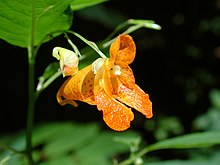Orange Jewelweed
| Orange jewelweed | |
|---|---|
 |
|
| Scientific classification | |
| Kingdom: | Plantae |
| (unranked): | Angiosperms |
| (unranked): | Eudicots |
| (unranked): | Asterids |
| Order: | Ericales |
| Family: | Balsaminaceae |
| Genus: | Impatiens |
| Species: | I. capensis |
| Binomial name | |
|
Impatiens capensis Meerb. |
|
| Synonyms | |
|
Impatiens biflora Walter |
|
Impatiens biflora Walter
Impatiens fulva Nutt.
Impatiens capensis, the orange jewelweed, common jewelweed, spotted jewelweed, spotted touch-me-not, or orange balsam, is an annual plant native to North America. It is common in bottomland soils, ditches, and along creeks, often growing side-by-side with its less common relative, Yellow Jewelweed (I. pallida).
Jewelweed plants grow 3 to 5 feet tall and bloom from late spring to early fall. The flowers are orange (or rarely yellow) with a three-lobed corolla; one of the calyx lobes is colored similarly to the corolla and forms a hooked conical spur at the back of the flower. Plants may also produce non-showy cleistogamous flowers, which do not require cross-pollination. The stems are somewhat translucent, succulent, and have swollen or darkened nodes (on only some plants). The seed pods are pendant and have projectile seeds that explode out of the pods when they are lightly touched, if ripe, which is where the name 'touch-me-not' comes from. The leaves appear to be silver or 'jeweled' when held underwater, which is possibly where the jewelweed name comes from.
Along with other species of jewelweed the juice of the leaves and stems is a traditional Native American remedy for skin rashes, including poison ivy and such use has been supported by at least one peer-reviewed study.
The species name "capensis", meaning "of the cape", is actually a misnomer, as Nicolaas Meerburgh was under the mistaken impression that it was native to the Cape of Good Hope, in southern Africa.
Impatiens capensis was transported in the 19th and 20th centuries to England, France, the Netherlands, Poland, Sweden, Finland, and potentially other areas of northern and central Europe. These naturalized populations persist in the absence of any common cultivation by people. This jewelweed species is quite similar to Impatiens noli-tangere, an Impatiens species native to Europe and Asia, as well as the other North American Impatiens. No evidence exists of natural hybrids, although the habitats occupied by the two species are very similar.
...
Wikipedia
